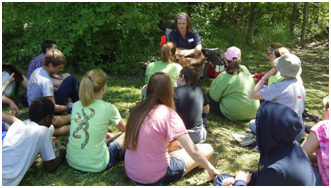By:
Jennifer Thum (ISDA) and Bettie Jacobs (Jay Co. SWCD)
For
the past ten years, Jay County Soil and Water Conservation District (SWCD)
along with ecologists, historical storytellers, NRCS and the IDNR, have
organized and hosted a wetland educational field day at the Limberlost Preserve
located in Jay County. The event is for
ALL Jay County 5th grade students. There are seven elementary schools, and to be
exact, that is 256 kids in all. The
field day provides a unique opportunity for state biologists and enforcement
officers, ecologists, scientists, and conservationists to come together and
share their passion for nature with students who might otherwise not learn
about wildlife in their own backyard. This
was my first year as a District Support Specialist for the Indiana State
Department of Agriculture and I was able to volunteer at this event; I am so
glad that I did. During the event, I
wandered to each of the nine learning stations and saw firsthand the excitement
on the kids’ faces as they were having fun and learning about animal pelts,
beaver dams, the insects that call the wetland home, and my favorite station,
the history of Limberlost as told by Betty Drinkut. As a parent, I think it’s wonderful that the
school district and the local conservation district organize an event that
allows the children to step outside the classroom and experience nature through
educational presentations, demonstrations, and hands-on activities that teach
them about the environment, wildlife, and wetlands.
When
the students arrive, they are accompanied by their teachers and chaperones through
a rotation of nine learning stations. The
learning stations are all based upon “Wetland Education”. The stations are 20 minutes in length and are
“manned” by staff of DNR, NRCS, and Friends of the Limberlost volunteers. Topics that are covered are:
Why Wetlands?
– Explains to the students the benefits of a wetland. This learning station is manned by Al Schott,
DNR;
What’s Slithering?
– Shares with the students some of the “cold-blooded” residents of the wetlands
including “preserved” species and a live snake. Manned by Curt Burnedette, the Educator at the
Limberlost Nature Preserve;
Birds of the Wetlands
– How the wetlands benefit our feathered friends. Manned by Connie Ronald, member/volunteer of
the Friends of the Limberlost;
Woodland Hike
– Students hike through a section of woods while trees are identified. Manned by two DNR staff members, Fred Affolder
& Lorraine Shier;
Insect Dig
– Living larvae and water dwellers are dug up from the wetlands. Students are then allowed the opportunity to
“sift” through harvested wetland bottom and discover/identify life! Manned by DNR;
Wetland Wildlife
– DNR Conservation Officers handle this station. They bring animal pelts for the students to
handle/identify and a Beaver Mount is made available as well. This past October we were really fortunate to
have a large, active beaver dam at this learning station site!
What do you see?
– NRCS Jayson Mas handles this station. The Jay SWCD obtained local grant funding and
30 pair of binoculars were purchased, allowing each student the opportunity to
“search” the wetland area with “eyes”!
For many students, this is the 1st time they’ve ever used
binoculars!
Native Plants
– Consists of a short hike while native grasses and plants are identified. We are fortunate to have Ben Hess, the
Regional Ecologist of the DNR Division of Nature Preserves, sharing his
knowledge with the students at this learning station.
History of the Limberlost
– Students learn how this area all came about, how it was originally a wetland,
and how several years attempts were made to drain and farm, unsuccessfully…. and
how Gene Stratton Porter was involved!
Ken Brunswick, retired DNR, generally handles this learning station and
even has an amusing, but true, story of how Limberlost got its name!
Curt
Burnedette – Limberlost Nature Center, Educator. “History of the Wetlands”
“What
Do You See?”
“Wetland
Wildlife”
“Why
Wetlands?” - Demonstrating Bottom Soil
Remover
“Insect
Dig”
Active
Beaver Dam – on site!

























